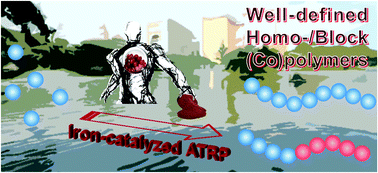Effects of various Cu(0), Fe(0), and proanthocyanidin reducing agents on Fe(iii)-catalysed ATRP for the synthesis of PMMA block copolymers and their self-assembly behaviours†
Abstract
We applied environmentally friendly ferric complexes (i.e., FeCl3/PPh3) to one of the most widely-used controlled/living polymerizations (CRP), atom transfer radical polymerisation (ATRP), for the preparation of well-defined poly(methyl methacrylate) (PMMA) homo- and block (co)polymers. Iron-catalysed supplemental activator and reducing agent (SARA) and activators regenerated by electron transfer (ARGET) ATRPs were investigated using cost-effective Cu(0), Fe(0), and the natural antioxidant proanthocyanidins (PC) as reducing agents. With different ratios of Fe(III)/Cu(0) and Fe(III)/Fe(0) for ATRPs of MMA, the former exhibited fast apparent reaction rates (kapps >3 × 10−5 s−1), but showed large PDI values (>1.6); the latter exhibited moderate kapps ( = ca. 7 × 10−6–3 × 10−5 s−1) with low PDI values (<1.45), indicating that moderate reactions could avoid the occurrence of undesired side reactions. In the case of Fe(III)/PC, interestingly, moderate kapps ( = ca. 3 × 10−6–8 × 10−6 s−1) with low PDI values (<1.30) were obtained. Through UV–Vis measurements and additional chain extension of MMA, the effective reduction of PC on Fe(III) was obviously observed and resulted in high chain functionality of the PMMA–Br macroinitiator. Subsequently, two more chain extensions of PMMA–Br with n-butyl methacrylate (BMA) and benzyl methacrylate (BzMA) were conducted to obtain well-defined PMMA100-b-PBMA537 (Mn,NMR = 86 300; PDI = 1.25) and PMMA100-b-PBzMA649 (Mn,NMR = 124 200; PDI = 1.35) block copolymers (BCPs). Their thermal properties were characterized by thermogravimetric analysis (TGA) and differential scanning calorimetry (DSC). The segmental segregation was characterized by small-angle X-ray scattering (SAXS) and atomic force microscopy (AFM). Interestingly, microphase separation was observed only in the PMMA100-b-PBMA537 BCP with an upper critical ordering temperature (UCOT) behaviour and acquired spherical nanostructure (d = ca. 25 nm). We thus demonstrate a “green” ATRP method mainly using the natural product PC to reduce the FeCl3/PPh3 complex for the preparation of well-defined polymethacrylate-based BCPs.



 Please wait while we load your content...
Please wait while we load your content...